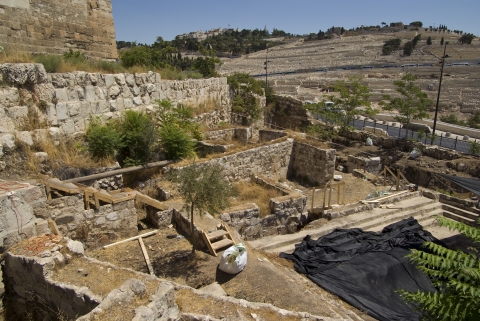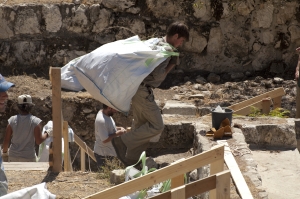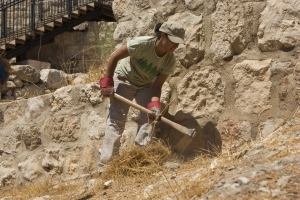
When I and 15 other students from Herbert W. Armstrong College arrived at the dig site on August 22 for our first day, we didn’t traverse through a jungle dodging poison darts and sand pits, we weren’t handed whips or tan fedoras and we didn’t find any hidden treasure. Instead, we were handed hoes, brushes, gloves, buckets and bags, and we trekked down dusty steps to a barren layout of stone walls that protruded from the dirt beneath. Perhaps our experience doesn’t sound exciting like an Indiana Jones movie, but it was in fact more exciting!
We learned quickly that the first couple days of “digging” are comprised of prep work and clean up—no digging at all. The first day, many of the men constructed stairs and bridges to enable navigating through the site more efficiently. The girls used tourya (hoes) to scrape off the top surface of soil that was filled with dead grass, trash and loose rocks. It felt a lot like doing yard work—almost like raking.
It was ironic being told to clean an area when the whole section was just a bunch of dirt and rocks. Nevertheless, we cleaned! The “dirty” dirt (the top part we scraped off) was loaded into bags that were 1 square meter in size. We could literally taste what it was like to be an archaeologist as clouds of dust surrounded us as we filled the ba’alot (bags).
After lunch, a shipment of supplies including wood, buckets, gloves, etc. were delivered to the site. All the students helped carry the supplies from the road side to the site, and then continued to clean up the areas in which we would soon be digging. After day one, we were dusty, sweaty and eager to start unearthing history.

HWAC junior Chris Eames helps clean up by hauling a ba’alot out of the dig site.
The second day was filled with many of the same tasks as the first. We carried heavy objects such as tree branches and the ba’alot that were stuffed full of grass and other dead vegetation up staircases and walls about 100 meters until we reached an area away from the dig site, near the southern wall of the Temple Mount. Several of the men worked to erect a shade tarp over the area to block the sun. This not only provides extra shade for the workers, it also enables better lighting for the pictures that will be taken throughout the excavation. It was definitely hard work, but every time we’d look up to wipe our brows, we’d glimpse the Mount of Olives or some other distinctive Jerusalem landmark. That’s right, we’re digging in Jerusalem! we would remember.
Day three came on a Sunday—the first day of the work week in Jerusalem. We were pumped and ready to dig, but the prep work was not yet finished. There was more cleaning to be done, but this time instead of using tourya we used broom brushes to make the different areas look level. It was finally starting to look like an actual excavation site instead of just a bunch of ancient ruins.

Alumna Sarah Patten cuts away unwanted grass and rocks.
As each area of the site was prepped and ready for digging, excavation photographer Ryan Friesen took pictures to record what the site looked like before the excavation started. By the afternoon, one area was finally ready for excavation, and alumnae Rachel Dattolo and Sarah Patten put on their gloves and began to dig.
It might just sound like a bunch of work, which it is—but it’s work with purpose. What makes it exciting is not only the location that is full of rich history, but simply the fact that it’s real! We are actually digging up tangible facts that verify biblical history. As we prepped the site, we were walking on and touching walls that were built nearly 2,500 years ago.
Learning the humble beginnings that every excavation site starts with only increased our anticipation for the results that would come from our hard work–and to see what lies just beneath the surface in the Holy City.
 In addition, HolyLandPhotos’ Blog also promoted the same video post along with another video post, “Restoring Byzantine Pottery.” They spotlighted Dr. Mazar’s quote about the accumulation of pottery found from the first temple period being perhaps the largest assemblage in Jerusalem so far. Another site, bibleplaces.com, mentioned our post “The 10th Century B.C.E. Scarab” in their “Weekend Roundup.”
In addition, HolyLandPhotos’ Blog also promoted the same video post along with another video post, “Restoring Byzantine Pottery.” They spotlighted Dr. Mazar’s quote about the accumulation of pottery found from the first temple period being perhaps the largest assemblage in Jerusalem so far. Another site, bibleplaces.com, mentioned our post “The 10th Century B.C.E. Scarab” in their “Weekend Roundup.”


